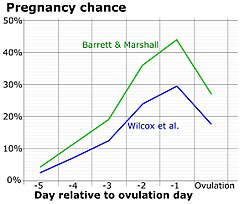排卵监测
外观
此条目可参照英语维基百科相应条目来扩充。 |
| Fertility awareness | |
|---|---|
 | |
| 背景 | |
| 生育控制种类 | 行为 |
| 初次使用日期 | 1950年代(粘液) 1930年代中期(基础体温) 1930年(Knaus-Ogino) |
| 失效比率 (第一年) | |
| 完美使用 | 征象体温法:0.4%[2] Ovulation method: 3%[2] TwoDay method:4%[2] Standard Days method:5% |
| 一般使用 | 征象体温法:2% Ovulation Method: 11–34% TwoDay Method: 14% Standard Days Method:11–14% 日历规律法:24% |
| 用法 | |
| 可逆性 | 可 |
| 注意事项 | 依使用者遵守严格程度和方法而不同 |
| 医师诊断 | 无 |
| 优点及缺点 | |
| 是否可以防止性传播疾病 | 无 |
| 周期 | Increased prediction |
| 好处 | 没有副作用,此方法也可以用在助孕、个人的自我觉察、婚姻亲密感较好 |
排卵监测[3](英语:Fertility awareness)是指一些用来判断女性月经周期中可孕期(危险期)和不孕期的的方法[4]。这些方法可用于避孕、助孕或监测性健康和生殖健康[4]。若用排卵监测手段来避孕,每年依然会约有15%的女性会怀孕[4]。若完全精准的监测,怀孕率为1%至12%不等,若随意监测,怀孕率为2%至34%不等,具体怀孕率取决于所使用的方法[5] 。排卵监测包括识别生育信号(基础体温、子宫颈粘液和宫颈位置)、记录月经周期天数、或使用尿液测试条(即排卵预测试剂盒)[4][5]。在最多达10天的可孕期(危险期)内,应实行性禁欲或使用其他避孕方法[5]。有些排卵监测方法可以用应用程序或用生育能力测试仪器来协助[5] 。
排卵期测定没有直接的副作用,不过无法通过排卵监测来预防性传染病(STI)[4][6]。若是青少女月经不规律、睡眠不规律,排卵监测也能也会失效[5]。
截至2020年为止,全球约有3300万女性使用此类避孕方法(占总避孕人数的3.5%)[7]。美国的比例也差不多,约为3.4%[4]。 自古以来就已经有一些关于生育及避孕的知识;不过一直到1920年至1970年期间,才有人提出用排卵监测手段来避孕[8]。这些措施实施的成本很低廉[6]。
相关条目
[编辑]参考
[编辑]- ^ Dunson, D.B.; Baird, D.D.; Wilcox, A.J.; Weinberg, C.R. Day-specific probabilities of clinical pregnancy based on two studies with imperfect measures of ovulation. Human Reproduction. 1999, 14 (7): 1835–1839. ISSN 1460-2350. PMID 10402400. doi:10.1093/humrep/14.7.1835
 .
.
- ^ 2.0 2.1 2.2 Trussell, James. Contraceptive efficacy. Hatcher, Robert A.; Trussell, James; Nelson, Anita L.; Cates, Willard Jr.; Kowal, Deborah; Policar, Michael S. (编). Contraceptive technology 20th revised. New York: Ardent Media. 2011: 779–863. ISBN 978-1-59708-004-0. ISSN 0091-9721. OCLC 781956734. Table 26–1 = Table 3–2 Percentage of women experiencing an unintended pregnancy during the first year of typical use and the first year of perfect use of contraception, and the percentage continuing use at the end of the first year. United States. 互联网档案馆的存档,存档日期2017-02-15.
- ^ 军医提醒:女性如何监测排卵-新华网. 新华网_让新闻离你更近. [2024-08-20] (中文).
- ^ 4.0 4.1 4.2 4.3 4.4 4.5 Cason, Patty; Cwiak, Carrie; Kowal, Deborah; Edelman, Alison. Contraceptive Technology 22. Jones & Bartlett Learning. 2023-09-26: 451–471 [2024-04-10]. ISBN 978-1-284-25503-4. (原始内容存档于2024-04-10) (英语).
- ^ 5.0 5.1 5.2 5.3 5.4 Urrutia, Rachel Peragallo; Polis, Chelsea B. Fertility awareness based methods for pregnancy prevention. BMJ. 2019-07-11, 366: l4245 [2024-04-09]. ISSN 0959-8138. PMID 31296535. S2CID 195893695. doi:10.1136/bmj.l4245. (原始内容存档于2024-03-26) (英语).
- ^ 6.0 6.1 Fertility Awareness Methods | Natural Birth Control. www.plannedparenthood.org. [2024-04-20]. (原始内容存档于2024-04-17) (英语).
- ^ World Family Planning 2022 (PDF). United Nations. 2022 [2024-03-22]. ISBN 9789211483765. (原始内容 (PDF)存档于2023-11-07).
- ^ Knight, Jane. The Complete Guide to Fertility Awareness. Routledge. 2016-11-03: PT32 [2024-04-20]. ISBN 978-1-317-65421-6. (原始内容存档于2024-04-21) (英语).
| ||||||||||||||||||||||||||||||||||||
